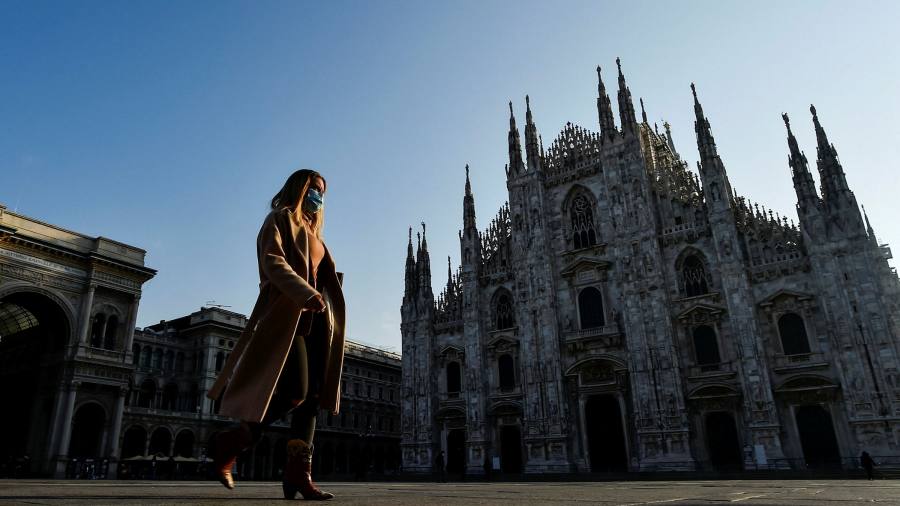[ad_1]
This time last year, chef Andrea Berton thought customers “might be overreacting†when they began cancelling tables at his Michelin-starred Milan restaurant amid a rise in cases of the concerning new coronavirus.
“It was a strange atmosphere,†he recalled this week. “The restaurant was suddenly empty at lunchtime and international customers kept calling to cancel bookings and events around the Salone del Mobile,†he added, referring to Milan’s annual furniture fair.
Neither he nor anyone else could have foreseen what would happen next. Days later, on March 8, Italy’s government ordered the immediate lockdown of the wealthy Lombardy region that includes Milan in an effort to stem the spread of Covid-19. The unheard-of restrictions were extended across the whole country the following day, confining 60m people to their homes.
It was the moment that Europe finally woke up to the threat from a virus that had emerged in China around the turn of the year. Within weeks, the entire continent — and soon the whole world — had been brought to heel by the pandemic.
“We were confronted with a virus we knew nothing about,†said Francesco Passerini, mayor of the small town of Codogno, an hour from Milan, where one of Italy’s earliest confirmed Covid-19 cases had been discovered in late February. “We didn’t know how to protect our community and we had people who were very ill. It felt like an impossible fight.â€

A year on, an end to Europe’s coronavirus crisis still seems some way off despite the hope offered by vaccines. Most of the continent’s 750m citizens continue to endure curbs on their daily lives and the economic and social toll has been enormous.
In Italy — as in some other EU countries such as nearby Greece and the Czech Republic — the number of new infections is rising as concerns intensify over the threat from new variants. Lombardy, still Italy’s worst-affected region, is grappling with thousands of new cases daily and hundreds of deaths each week.
On Friday, a new two-week partial lockdown came into force across the region, with offices closed and employees told to work from home. Schools and playgrounds are shut and hospitality and travel are banned, although shops remain open — for now.
Yet as cases tick higher, experts fear it is only a matter of time before the curbs are extended.
“It won’t be long before the whole country goes back into the ‘red zone’,†said Guido Bertolaso, Lombardy’s vaccine adviser, this week, referring to the most stringent level in Italy’s coloured tier system.

“Unfortunately it’s not over,†said Passerini, the Codogno mayor. “But it’s not comparable with last year because we’ve learned to live with the virus and now we have a vaccine. So we have something to look forward to.â€
Looking back evokes painful memories. The most vivid was the day he and other volunteers had to empty a church to make room for dozens of coffins. “I remember watching the dead bodies being brought in and the church, a place of hope, suddenly turn into a morgue. I couldn’t believe it was happening,†he said.
In the weeks and months that followed, Carla Sozzani, owner of 10 Corso Como, a cultural, shopping and dining destination in Milan’s nightlife district, could not get used to the silence in a city known as a teeming hub for industry, banking and fashion.
“The only noises you could hear, day and night, were the ambulances and the drones they used to check nobody was leaving their homes,†she said. “It was unsettling.â€
Mired in a series of lockdowns, Milan has welcomed only a fraction of the 10m tourists who came in 2019, a shortfall that has put immense strain on its economy.
There is hope that the new government of Mario Draghi, an experienced crisis manager who formerly ran the European Central Bank, can bring improvements by speeding up the vaccine rollout and leading an economic recovery.
Sozzani, a self-confessed optimist by nature, was certain that Milan would regain its vigour in time for the rescheduled Salone del Mobile in September, once more people had been inoculated. “The fair is a symbol of Milan and it will represent its rebirth,†she said.
In a sign of his frustration at the slow rollout, Draghi has moved to block the export of 250,000 Oxford/AstraZeneca doses destined for Australia so they could be used in Italy. As of this week, however, under 6 per cent of Italians had received a first vaccine dose.
One Milan-based anaesthesiologist, who did not wish to be named, also warned that intensive care units in hospitals across the region were rapidly filling up again.
“It reminds me of last spring,†she said. “The vaccine makes us hope for the best but we need to plan for the worst, because the rollout is too slow and people are dying.â€
Berton was this week forced to close his restaurant again, a “stop-go approach†that he said would be the death of his and other businesses in the city.
“I would never have imagined it would last this long,†he added. “After a year we’re back to square one.â€
Â
[ad_2]
Source link






